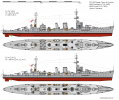Hi all, apologies for the sabbatical, I went paddling up the channel in a boat and popped into Amsterdam for a Heineken to celebrate my wife's 60th birthday, an event that seems to take a year to celebrate.
Anyway, onwards
Thank you, The Mole's Revenge, that's a good question, and I would have come back with, well its just what happened historically. Except, checking my notes, I'm very uncomfortable saying that now, given the poor quality of source I have.
Durban was one of the
Danae class light cruisers which were completed just after WW1, with an armament of six single mount 6-inch guns, and two 3-inch guns for AA defence. Sometime in the interwar years, all ships of the class had the two 3-inch guns replaced by 4-inch, with a third being added, and the two 2-pdr Pom-Poms added on the bridge wings. OK so far, now my main source is,
https://en.wikipedia.org/wiki/Danae-class_cruiser, which then goes on to say all ships received upgrades, with radar and 20mm Oerlikon guns, early WW2, and this is what I based my upgrade on.
And this is where the problems come, firstly, this is Wikipedia, which is ok for general stuff, but is often found wanting on finer detail. Secondly, all Royal Naval ships received upgrades when and where they could, with what was available, and I'm aware there could be differences between ships of the same class. Thirdly by WW2, the
Danae class was strictly second class, so just like the preceding C, alternative uses were being explored, with some undergoing conversion to AA cruisers. And lastly I have no clear idea of
Durban's upgrades.
And then The Mole's Revenge question on why would you downgrade from a 40mm to a 20mm, losing range and weight of shell. To answer this, I'd turn to
http://www.navweaps.com/Weapons/WNBR_2pounder_m2.php which mentions that the 2 Pdrs were prone to stoppages and jams. I could speculate that possibly it was easier to add more Oerlikon's, they may be an easier install, and keeping to one type of light AA helps with ammunition logistics. To add to my conundrum, I don't think the Royal Navy was overrun with spare 20mm Oerlikon mounts in the autumn of 1941, making the possibility of this change of armament less likely.
Moving forward with this, I've posted a question of what armament HMS
Durban carried on a couple of forums, and will listen to what comes back from them, along with what you all might post, and depending on all of that, I might just edit out the light AA upgrade, as this is defiantly not storyline critical.
